Menu
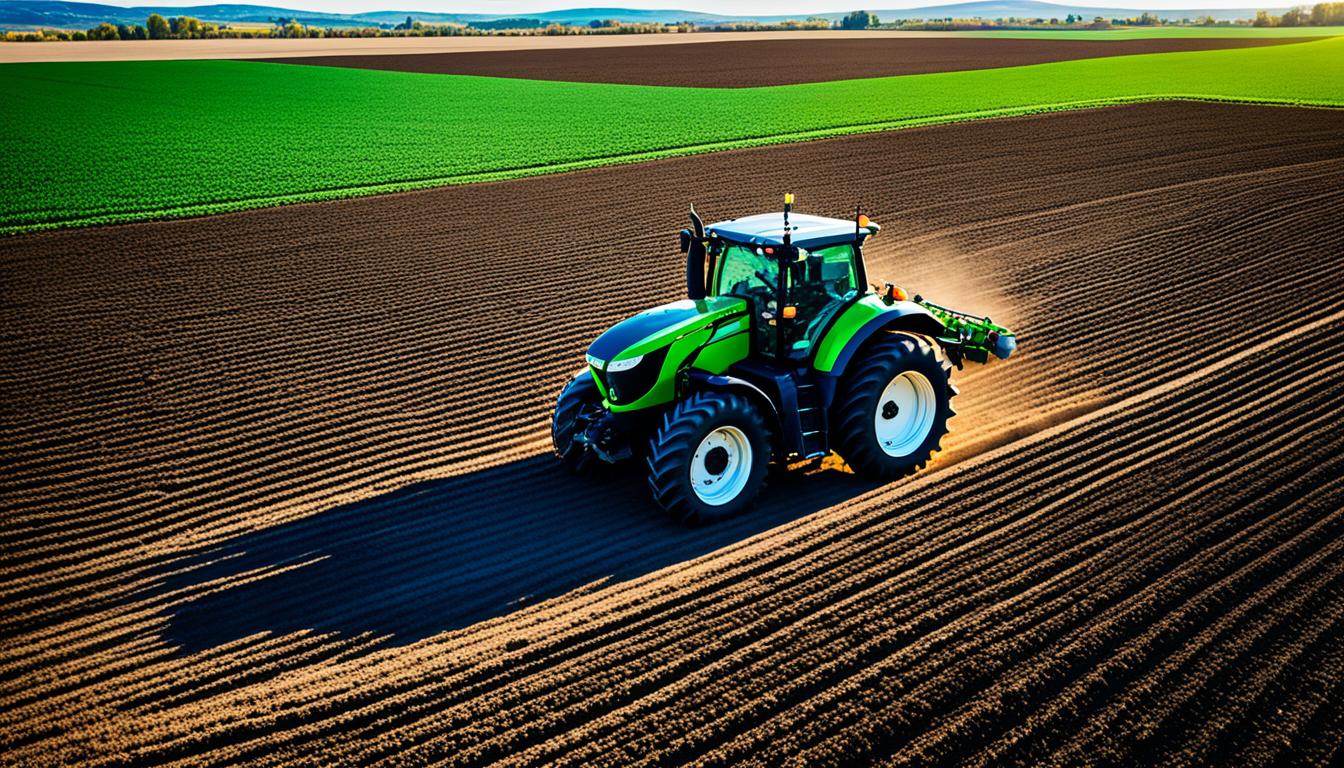
Smart tractors, like Massey Ferguson’s MF 245 4WD model, can go as fast as 34.05 kmph. This is much faster than their 2WD counterparts. Such advances in smart farming show how ICT in agriculture is changing the game. TYM stands out with its self-driving agricultural machines. Machines, like the T130 model, use digital technology like D.A.V.E. to work smarter. This means using resources better and producing less waste.
Such smart machines don’t just help with lack of workers. They also let farming happen all day and night, making work safer and saving a lot of money.
The move from traditional to smart tractors is an amazing journey in agricultural innovation and tractor industry transformations. We’ve seen farm machinery evolve from old steam engines to today’s advanced farming technology. This journey shows a strong push for better operational efficiency and managing resources well.
In the early 1900s, tractors started to change farming by using steam instead of animals. The Fordson Model F and John Deere Model D from the 1920s impressed with their power. They use the 4.1-litre and 20hp engine, and two-cylinder 27hp engine respectively.
Hydraulics were added in the 1940s, making tractors stronger and more useful. This was a big step in agricultural innovation. Electronic controls in the 1970s made tractors more fuel-efficient and easier to manage. Tractors also got solid rubber tyres in 1918, making them use fuel better and cause less damage. The addition of hydraulic systems and power take-offs (PTOs) made them more flexible and efficient.
Today, smart tractors have changed farming the most. They use the latest sensors, GPS, and connect to other devices. These tractors allow precision farming with GPS guidance and checking soil and crop health in real-time. They offer incredible accuracy and efficiency.
Now, smart tractors can steer themselves using GNSS and RTK technology. Models like the self-driving tractors from TYM show the move towards farming that uses less human effort and more data. This change makes farming safer and more efficient by reducing the need for manual work and the chance of errors.
| Era | Major Advancements |
|---|---|
| Early 1900s | First steam-powered tractors, replacing draft animals. |
| 1920s-1940s | Golden Age of Tractors; Iconic models from Fordson and John Deere. |
| 1940s | Introduction of hydraulics for greater efficiency and versatility. |
| 1970s | Shift to electronic controls for better fuel efficiency and power management. |
| Modern Era | Emergence of smart tractors with GPS, sensors, and connectivity for precision farming. |
The shift from traditional to smart tractors highlights a wide range of agricultural innovation and advanced farming technology. It shows where the future of farming is headed.
Precision agriculture marks the dawn of smart agricultural practices. It blends cutting-edge technology with data analytics. This combo makes farming efficient, cost-friendly, and eco-friendly. It all started in the 1990s, with the birth of handheld devices. These gadgets let farmers study soil samples and field boundaries on the go. Since then, this method has made some big strides.
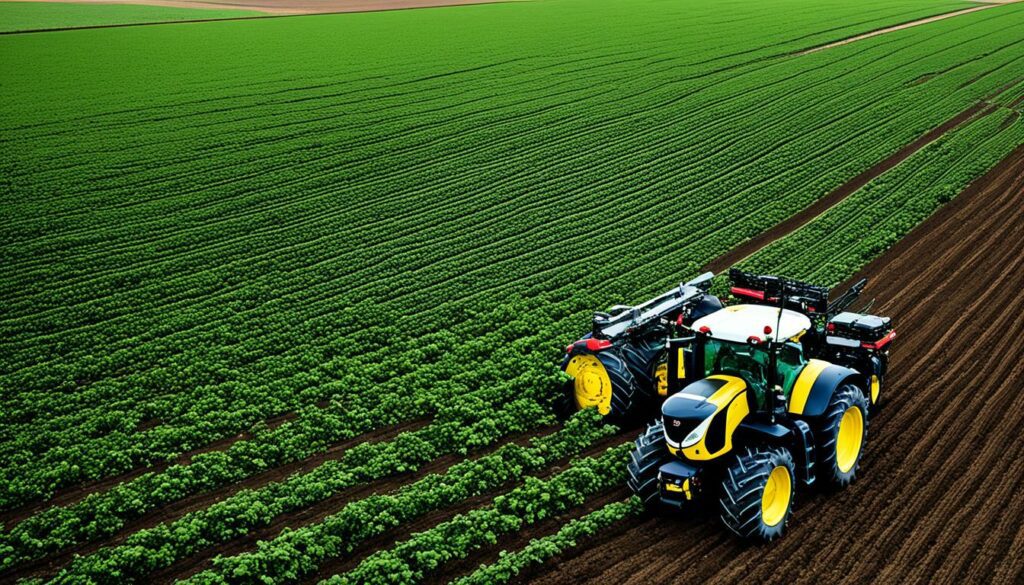
Precision farming technologies now include things like soil and crop sensors. They keep an eye on nutrients in the soil and moisture levels. This helps farmers give their crops exactly what they need. Then, there’s satellite imagery and remote sensing. They offer instant pictures of crop health. This turns farming into something more like a science.
Firms such as John Deere, Agmatix, and AGCO’s Precision Planting are leading this change. They have created GPS-guided systems that cut down on wasted effort. This ensures farmers use resources wisely. It supports a style of farming that can keep going without harming the planet.
Automation and robots are also key. They include tractors that drive themselves and sprinkler systems that work on their own. These machines boost how much work gets done. But they also help the environment. They use resources well and they don’t make a lot of waste.
Using big data is also a game-changer. It handles loads of info to guess what might happen next with the crops. This helps spot possible problems early. Then, it suggests ways to fix things and get more crops. Another big help is the way it uses maps in great detail. This shows farmers all they need to know about their land. They can then plan their work better.
| Company | Contributions |
|---|---|
| John Deere | Testing autonomous tractors in seven US states |
| Agmatix | Advanced soil and crop sensors |
| AGCO’s Precision Planting | GPS-based guidance systems |
| Greeneye Technology | Smart spraying system reducing herbicide use by 78% |
| Mast Reforestation | Drones for restoring fire-damaged land |
Many different people are working together in precision agriculture. This mix includes big tech companies, researchers, farm experts, and actual farmers. Their teamwork is crucial for the future. They’re all focused on making sure the world has enough food and that farming is kind to the planet. By 2050, there could be 9.7 billion of us. AI in agriculture is already a big deal, worth $1.44 billion in 2022. By 2032, it could be worth $11.96 billion.
Modern farms are getting better with sensor-driven machines. These tools plant, fertilise, and water crops with more precision. This means less waste and better use of resources.
GPS and sensors are changing farming for the better. They help manage fields inch by inch. These machines collect data in real-time, helping farmers to act quickly.
The latest tractors from companies like John Deere and Kubota are smart. They use special algorithms to find the best paths. This smart planning makes farming more efficient, saving fuel and time.
Using resources wisely is key to sustainable farming. With precision tools, farmers can watch and change how they use water and fertilisers. This is seen in vertical farms, which can use much less water than usual.
| Key Statistics | Values |
|---|---|
| Global Greenhouse Market Annual Vegetable Production | US $350 billion |
| Precision Agriculture Market by 2025 | $43.4 billion |
| Farm Tractor Market Value in 2021 | $63.9 billion |
| Projected Farm Tractor Market Value by 2030 | $105.6 billion |
As we move towards a future with 8.6 billion people by 2030, farming’s sustainability is key. Smart tractors bring big environmental wins. They use technology to apply fertilisers and herbicides accurately. This cuts down on harmful runoff and protects nature.
The National Academy of Sciences highlights that agriculture is undergoing a revolution, significantly triggered by the increasing use of Information and Communication Technology (ICT).
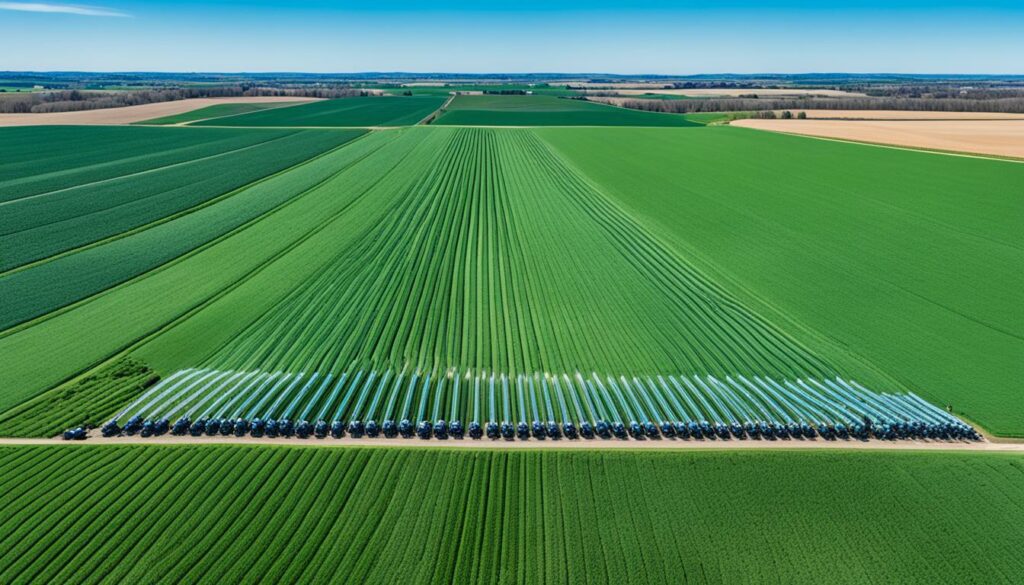
Smart tractors help farming use water better, which is crucial since farming uses 70% of all water. They use sensors to manage water well, saving this essential resource. Monarch Tractor shows that smart farming not only protects the environment but also cuts costs significantly. Their customers have saved over $198,000 in fuel alone.
By precisely controlling work, smart tractors also reduce harmful gas emissions. These gases come from farming and make up 10% to 14% of the world’s total. Smart tractors cut fuel waste, leading to a cleaner earth. John Deere has shown a 19% drop in emissions since 2017, proving the benefits are real.
Using eco-friendly materials in farm machines is a must. John Deere is pushing to sell more remanufactured and rebuilt items. They also aim to make their products from more recyclable or renewable materials. Investing in smart tractors not only helps with work but also aids the environment. This move is a big plus for smart farming’s future.
Autonomous farming equipment is changing how farms work. These machines are tackling the big problem of not having enough workers in agriculture. As farmers get older and fewer people choose farming, we need machines that can work on their own.
One key benefit of this new tech is it doesn’t need people to work with it. This means farms can operate well even if there aren’t many human workers. Take the John Deere 8R 410, for example. It has up to 405 horsepower and lets farmers continue to produce a lot without as many hands.
The Monarch Tractor MK-V is a standout, running on batteries with 250 horsepower. It can work round the clock, which is a game-changer during busy seasons like harvesting. Priced at around $50,000, it’s a cost-effective way to keep farms running with no pause.
This tech also allows farmers to manage their farms from afar. Being able to watch over and control machinery from a central place makes everything more agile. The New Holland T7.315 from CNH Industrial, introduced in 2020, is a prime example. It ushers in a new era of managing large farms effectively with its autonomous functions.
Here’s a breakdown of some key autonomous tractors:
| Tractor Model | Engine Horsepower | Price Range | Key Features |
|---|---|---|---|
| John Deere 8R 410 | 177-405 | $500,000 – $800,000 | Continuous operation, high efficiency |
| Fendt 1000 Vario | 112-517 | Varied | Wide horsepower range, versatile |
| Monarch Tractor MK-V | 250 | $50,000 | Battery-powered, collision prevention |
| New Holland T7.315 | Specified with platform arrival | Varied | Autonomous, connected tech |
| Yanmar YT5115N Prototype | N/A | Prototype | Lidar, stereo cameras |
Smart farming has brought in an era of saving money in agriculture. It does this by using the latest technology to farm in smarter ways. For example, autonomous tractors like the TYM T130, which started operations in 2021, have cut down farm costs a lot. These machines are very good at their job since they started in 2013. They are a key part of why farming is now cheaper.
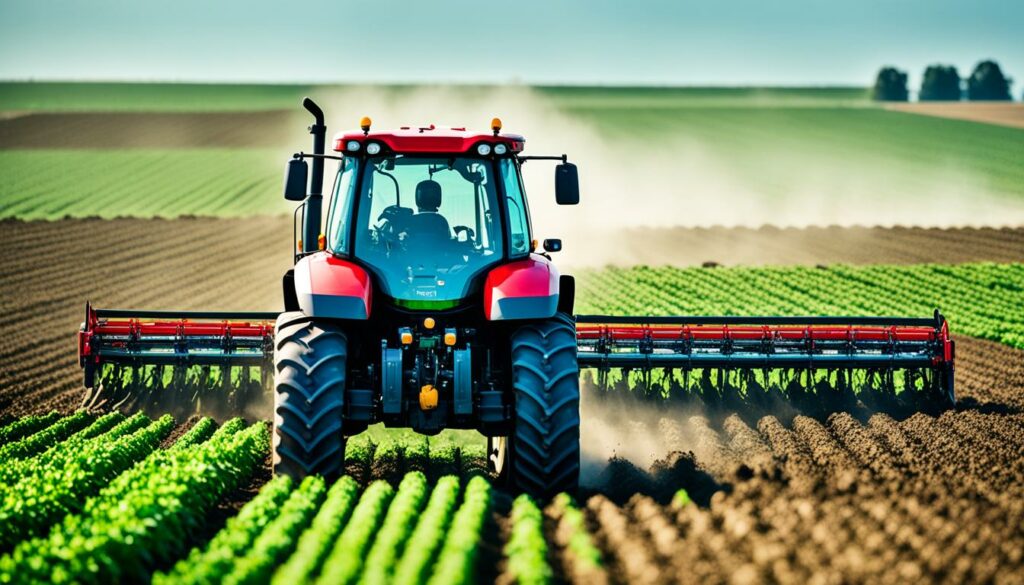
Smart farming is great at using less fuel. This is because it plans better routes to move around the fields. By connecting machines to computers, farms get to know about their crops and soil instantly. This helps them to make quick changes to save money and grow better crops.
Spending less on running the farm can impact the whole world. There might be a 22% drop in how much farming costs globally, thanks to AI and smart farming. For labour, which usually eats up 8% of farm expenses, using advanced machines means costs can go down by a lot. This means food prices could be cheaper for everyone.
Here are some key areas where money is saved:
| Parameter | Cost Reduction Percentage |
|---|---|
| Seed, Fertiliser, and Chemical Costs | 27% |
| Fuel, Lubricant, Electricity, and Repairs | 20% |
| Corn, Soybean, and Wheat Operating Costs (US) | 26% – 31% |
| Overall Agricultural Operating Costs (Global) | 22% |
Now, a lot of farms around the world, about 75-80%, are using AI and smart tech. This big change is making farming more efficient and cheaper. It’s not just about saving money; it’s also about keeping the environment safe and the agriculture going strong.
Autonomous technology shapes safer farming. Innovations like smart tractors and farm robotics, such as TYM’s T130, increase efficiency. They make fields safer places to work.
Farm accidents often happen due to tired workers. Smart tractors cut this risk by doing hard jobs themselves. This lets farmers watch over things rather than work manually. It means a safer farm and fewer accidents.
Modern tractors have key safety features. They turn off the engine if there’s an accident or they steer off course. This lowers the chance of dangers. Plus, sensors can tell the soil and spot obstacles. This stops accidents before they happen. Monarch’s inventions, like the Smart 4-wheel Drive and Hill Hold, stop tractors from tipping over. This is a top cause of farm accidents.
These tech advancements show how farming safety is growing. With autonomous tools, farms are safe and efficient. It’s about using robots to keep farms both safe and productive.
The role of IoT in agriculture is key to the success of smart tractors. This technology allows us to gather, share, and deeply review data. These actions boost efficiency and make farming better.
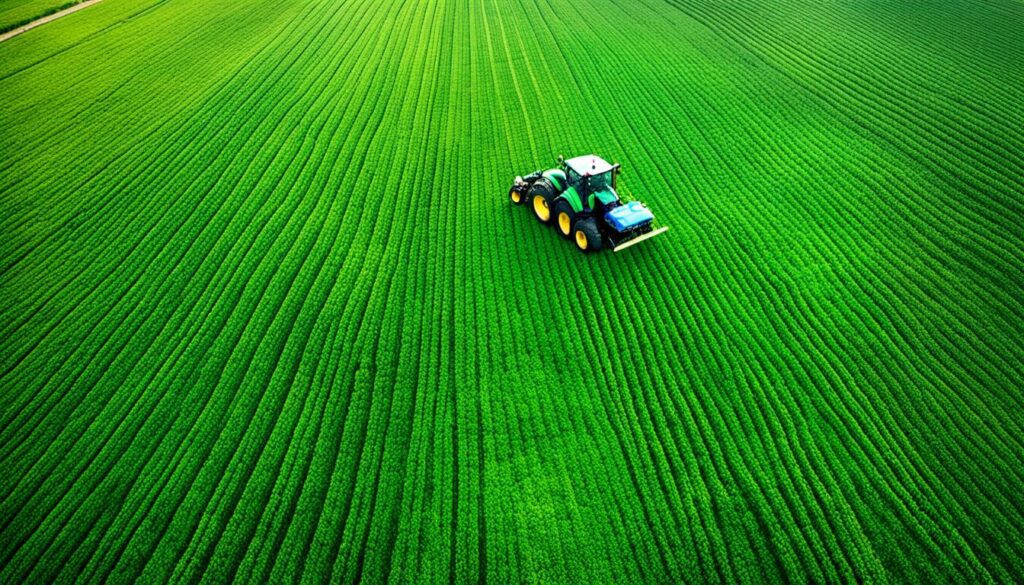
With IoT sensors, we get real-time data about the soil and crops. For example, they can tell exactly how moist the soil is. This data lets the farm’s systems adjust its watering, saving 35% of water and keeping crop yields high.
In Kenya, IoT has made big changes in farming. Sensors and AI watch over cow health, reducing the number of cows that die by 15%. Drones and sensors have also been key in spotting crop diseases early. This led to a 25% growth in crop production.
Precision farming with IoT boosts crop yields by up to 20% and saves resources. A winery in California cut water use by 20% using drones. This saved loads of water.
IoT also helps cut costs. By managing water, fertiliser, and pesticides better, it’s possible to save money and help the environment. A Dutch greenhouse saw a 30% bump in crop yield thanks to this.
| Technology | Impact | Result |
|---|---|---|
| Drones and Sensors | Accurate Disease and Pest Detection | 25% Increase in Crop Production |
| AI-Powered Analytics | Health Monitoring | 15% Reduction in Livestock Mortality |
| IoT-Enabled Irrigation | Optimised Water Usage | 35% Reduction in Water Usage |
| Automated Systems | Climate and Nutrient Control | 30% Increase in Yield |
IoT makes farming efficient and raises crop yields but faces challenges. Smaller farmers might find it hard to pay for the tech. Solution providers and consultants are crucial to helping them use IoT well.
In summary, IoT paves the way for smart farming and boosts agriculture through data and precise practices. It increases yield, lessens waste, and supports the earth.
Artificial intelligence is transforming agriculture with AI-powered tractors. These tractors use real-time data to make quick, smart decisions. They also use predictive analytics to work more efficiently and wisely manage resources.
AI-powered tractors are changing the game by processing data on the spot. John Deere’s See & Spray can tell crops from weeds with 20 images per second. This means farmers can react fast to changing field conditions.
Such abilities raise productivity and care for the land in farming operations. They help in saving resources, making farming better for everyone.
AI tractors can even guess when they might break down. This lets them avoid stoppages and last longer. John Deere’s CommandCab is a great example, using AI to spot problems early.
Less time off means more crops and better profit for farms. Predictive maintenance is a big win for farming businesses all around.
Besides, machines like semi-autonomous tractors can spray crops by themselves. They boost productivity by more than 30 per cent. These advances show how AI in farming is really making a difference.
As AI gets even smarter, so does the future of farming. AI tractors are at the forefront, making agriculture more efficient and automated.
Smart tractors have changed how we apply fertilisers and herbicides. They’ve made farming more precise while caring for the environment. These systems make sure each plant gets just the right amount of treatment, cutting back on waste.
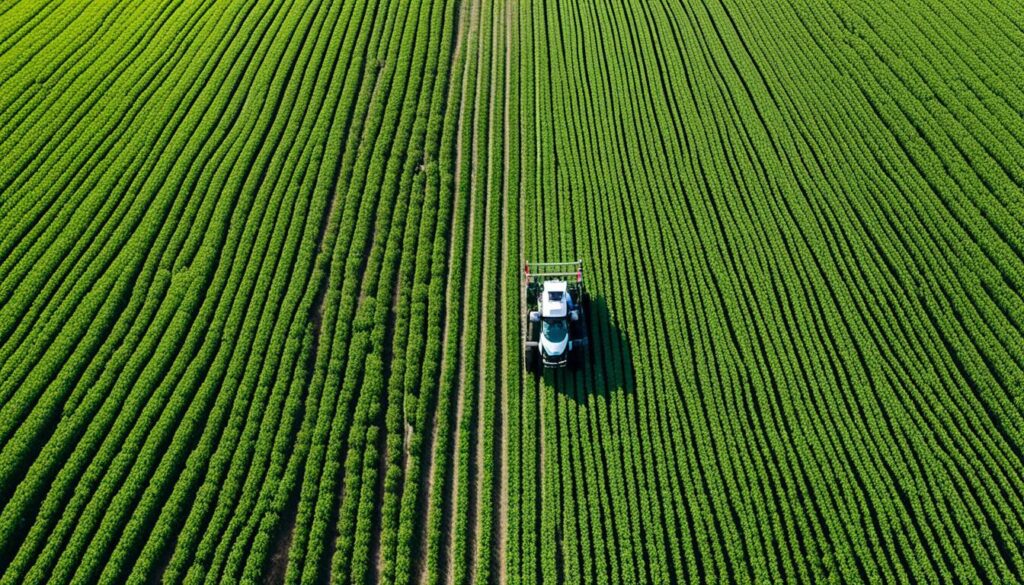
Since 2013, TYM has led the way with self-driving tractors. These tractors are easy to use and bring new levels of precision to Korea. The way we farm affects a lot of the world’s greenhouse gases. So, using resources accurately is very important.
The key benefit of these systems is using less product by avoiding overspray. This cuts down on waste. And, self-driving tractors don’t get tired. They can work all day and night, making sure crops are treated well.
Let’s look at some key stats about using technology in farming:
| Technology | Benefits |
|---|---|
| Precision Agriculture Systems | Optimising traditional resources and managing diversified decision-making |
| Variable Rate Technology (VRT) | Applying inputs at tailored rates across different field areas |
| GPS | Mapping irrigation systems, detecting problem areas, and enabling precise applications |
| Unmanned Aerial Vehicles (UAVs) | Detailed field analysis with less fuel consumption |
| Satellite Remote Sensing | Real-time crop health monitoring and anomaly detection |
| Yield Monitoring and Mapping | Creating detailed field maps for effective decision-making |
Connected farm vehicles are changing the game in agriculture. They link with farm management systems and boost efficiency.
These vehicles work smoothly with smart farm systems. This means better data for smarter farming. A zero-emission tractor, for example, can mow a huge area without stopping thanks to its long-lasting battery.
Real-time monitoring is a game-changer for farmers. They can instantly respond to any changes in the field. Consider a tractor that can provide power for other devices. This can cut some farming costs by a quarter. Another tractor that helps with spraying can increase how much gets done by a third.
| Vehicle | Features | Efficiency | Cost Savings |
|---|---|---|---|
| Zero Emission Tractor | Battery charge lasting 4.5 hours | Mows 10,000 m² of lawn | Reduced operational downtime |
| eAutoPowr Transmission | Provides up to 100kW of power | Optimises field operations | 25% reduction in slurry costs |
| Semi-Autonomous Tractor | Integrated crop sprayer | 30% increase in productivity | Enhanced resource utilisation |
Connected vehicles are at the forefront of precise farming. They make farming more sustainable and profitable. By using real-time data, they help farmers meet the world’s growing food needs.
Modern agriculture is on the move, thanks to smart tractors. They bring essential data for farming. These high-tech tractors help farmers understand their fields better. This means better choices and bigger harvests are possible.
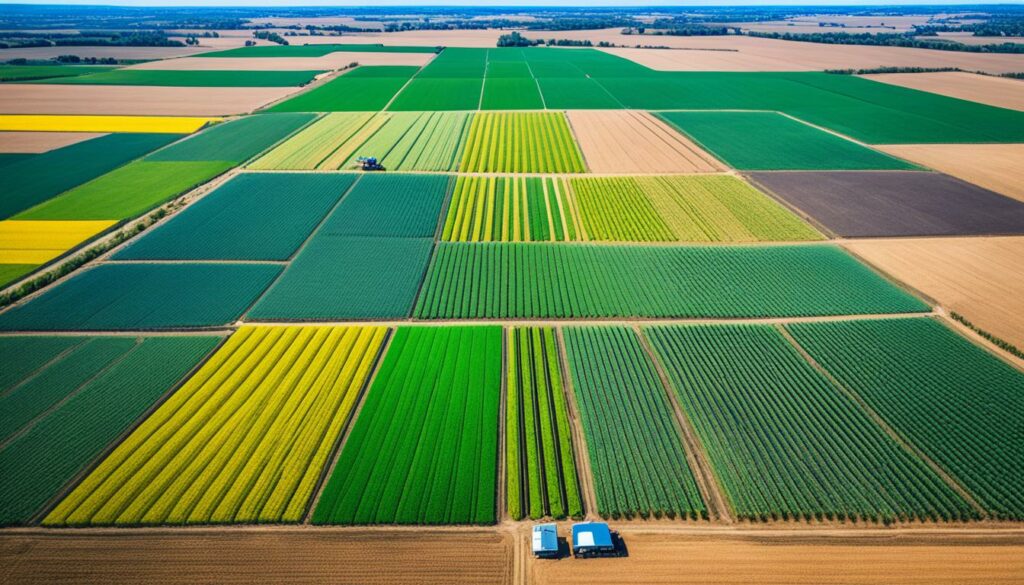
Smart tractors give farmers key information on soil. They track things like nutrients, moisture, and pH. This info means farmers know exactly what their crops need. It leads to well-kept fields and more crops.
Smart tractors are key to keeping crops healthy. They use sensors and satellites to watch over fields. They spot problems early, like bugs or diseases. This early warning system saves lots of crops and keeps plants strong.
Important decisions on planting and harvesting get a boost from data. Farmers use weather and soil facts to plan when to plant. They get help from real-time weather and predictions for harvesting. This helps harvest the best-quality crops.
Here’s how types of data help in farming:
| Data Type | Application |
|---|---|
| Weather Data | Helps create fire risk maps for safer farms. |
| Soil Information | Guides in watching soil and managing nutrients better. |
| Crop Data | Aids in keeping crops healthy and fighting diseases. |
| Satellite Images | Give clear looks at farms for better farming methods. |
| Machinery Data | Makes farm tools work better and last longer. |
| Market Trends | Guides smart planting and harvesting by showing what’s needed. |
Using these types of data brings farming a step forward. Smart tractors are leading the change. As more data and tools get developed, farming gets even more precise and efficient.
Since 2013, TYM has led in agricultural automation, pushing farming advancements. They’ve focused on improving productivity and efficiency. Their self-driving tractors, especially the 2021 model, are highly precise in Korea. This shows their dedication to tech excellence.
The T130 from TYM agricultural automation can farm 24/7. It’s perfect for planting and harvesting times. This boosts farm work during important times and helps with the issue of fewer young farmers.
TYM’s autonomous tractors bring new agri-jobs like tech support and data analysis. This both offers cool work and makes farms more efficient.
TYM’s tech also saves costs. It’s better for the planet, manages workers smarter, and cuts waste. These savings can help lower food prices for everyone, making a big impact on the economy.
Some good things from TYM’s work are safer farms and less tired workers. Autonomous tractors mean fewer dangers from human errors, improving farm safety a lot.
| Benefit | Impact | t
|---|---|
| Increased Productivity | Continuous 24/7 operations enhance efficiency. | t
| Cost Savings | Reduced operational expenses and potential reduction in food prices for consumers. | t
| Enhanced Safety | Eliminates operator fatigue risks, reducing accidental hazards. | t
| Create Jobs | Opens opportunities in tech support and data analysis within agriculture. | t
TYM is a key player in the industry, using autonomous systems to collect big data. This data helps with smart farming decisions. They’re committed to sustainable tech and managing farms well in Korea and worldwide.
Smart tractors are changing farming by increasing crop yields and saving costs. The TYM self-driving tractor, from Korea in 2021, showed top-notch precision. By using smart technology, it cuts down on waste and makes better use of resources.
“Since 2013, TYM has been adding new features to their tractors. This shows big progress in farming tech,” said a recent report.
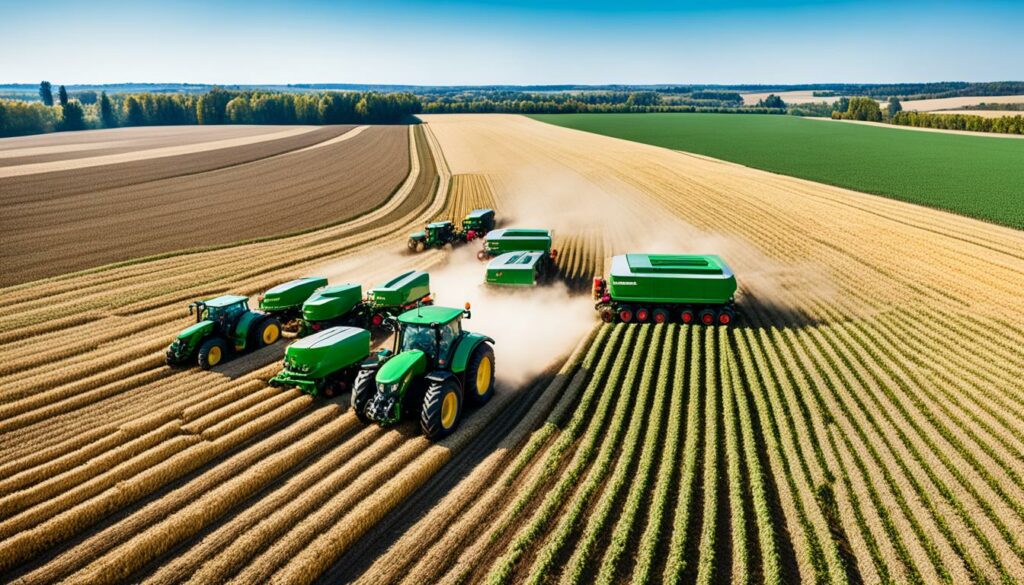
Smart farming brings big economic benefits. The average age of farmers is going up, so there’s a need for systems that work all the time. This saves money and boosts how much farming can get done.
Smart tractors are lowering costs in farming. This might mean food gets cheaper for us. Monarch Tractor’s electric models, for example, cut fuel costs by nearly $200,000 in the first year. The MK-V tractor also collects data, making renewable energy investments pay off more.
Farmers save money using systems like Monarch’s WingspanAI. They get info that helps them be more efficient right away. By 2030, the market for electric tractors is expected to be worth over $3 billion. This shows smart farming’s money-saving power.
| Aspect | Impact |
|---|---|
| Operational Costs | Reduced due to continuous, precise automation |
| Fuel Savings | Significant, with Monarch Tractor users saving over $198,000 in the first year |
| New Job Creation | Tech support, data analysis, and other roles |
| Market Growth | Electric tractor market projected to grow substantially by 2030 |
Being an early user of smart tractors prepares farmers for future success. It helps with rising costs and makes farming greener. Government help makes getting these tractors easier. Smart tractors are changing farming for the better and for the long run.
The future looks bright for autonomous farming gear. Yet, hurdles like big costs need tackling for it to go mainstream. A key challenge is the pricey nature of electric and self-driving tractors.
For instance, the John Deere 8R 410 Autonomous Tractor can cost between $500,000 to $800,000. This price tag is a major turn-off for those who farm on a smaller scale. On the bright side, the Monarch Tractor MK-V is more budget-friendly at $50,000. But, the costs of these high-tech machines still keep many potential buyers away.
Getting used to advanced farm tech is not easy. For example, New Holland’s IntelliTurn and Yanmar’s YT5115N Prototype need farmers to be skilled in using and fixing these systems. They come with features like automated turns and high-tech sensors.
Data protection is critical in smart farming due to the use of sensitive data. The risk of cyberattacks is real and rising. To keep farm info safe, strong cybersecurity steps are a must as tractors get smarter and more connected.
However, the smart agri sector is always coming up with new ideas. There are moves to push for more electric farming gear and cleaner energy. This points to a hopeful future for farming equipment that runs itself.
Looking back on the progress of smart tractors, it’s easy to see their big impact on farming today. They use IoT and connectivity to change how farming works. Farmers can now use data to make better choices, manage resources, and grow better crops. Things like sensors for soil make farming smarter and more efficient.
Smart tractors also make farming across large areas much easier. They can be controlled and checked from far away, which saves time. With early warnings on repairs, they keep working without big problems.
The use of precise tech for planting and harvesting also helps. It makes farming both better for the environment and more productive.
Although smart tractors cost a lot at first, they offer huge benefits. They take care of crops, help with detailed farming, and work well with other farming tech. This sets a path for the future, where smart farming with these advanced machines will be common. For more insights into the impact of smart tractors and the future of smart farming, visit this detailed resource.
Smart tractors are a key part of modern farming using advanced technology. They rely on ICT, GPS, and AI to work more efficiently. This allows them to operate without constant human control.
They make better use of resources and help farmers work sustainably. This means they’re good for both the farmer and the environment.
The tractor’s journey has been amazing. It started with steam engines and now includes high-tech sensors and GPS. With each leap, tractors become smarter and more efficient.
These innovations help farmers work with precision. Smart tractors make farming less laborious and more productive than ever before.
Precision farming uses the latest tech to make better decisions. This includes GPS, images from satellites, and sensors all over the farm. These tools help farmers do their work with great accuracy.
Using such tech cuts waste and lessens the farm’s impact on the environment. This is good news for the planet and for the farmer’s wallet.
GPS and sensors take farming accuracy to a whole new level. They help with seeding, fertilising, and watering crops just right.
This means using less fuel and still getting more from the land. Smart ways of farming save money and are good for the environment.
Smart tractors are a big part of farming that’s good for the planet. They spread fertilisers and herbicides exactly where they’re needed. This stops waste and pollution.
By being so precise, they help farmers keep the land healthy. This is vital for long-term farming success.
Smart tractors can do a lot of farming work on their own. They don’t need drivers all the time, even at night or during busy harvests. This cuts down on the need for extra people to help on the farm.
Smart tractors are great for saving money in farming. They pick the best routes to use less fuel. They make sure resources aren’t wasted.
They also reduce the need for lots of workers. All these things lower how much farming costs. This can also make food cheaper for us to buy.
Auto farming keeps people safer by avoiding tired drivers. This kind of farming tech is designed to protect workers.
It has sensors to avoid accidents and turn off automatically when needed. These features make working on the farm a lot safer.
The Internet of Things (IoT) is at the heart of smart tractors. It collects and analyses data in real time. This info helps farmers make better decisions faster.
It looks after the soil and checks on how the crops are doing. IoT is key to making farming as smart as possible.
AI in tractors means they can get smarter over time. They use data to make choices on their own. They can even know when they might need to be fixed before there’s a problem.
Precision farming isn’t just about better crops; it’s about using less chemicals too. With precision, farms cut down on waste. This is good for the farmer’s pocket and the environment.
Connected vehicles mean the farm can react quickly to any changes. They’re linked to systems that keep everything running smoothly.
With this tech, farming becomes more efficient. This means better results for the farmer.
Smart tractors give out lots of data. This information is gold for making the best farming decisions. It helps farmers work with the weather and other changes.
TYM is pushing the boundaries in farming automation. Since 2013, they’ve been improving tractors and introducing smart farming tech.
They’re a big part of making farming more intelligent and productive. Their work is changing how we farm for the better.
Smart tractors are a game-changer for the economy. They boost crop production and cut down on work costs. This can lower food prices and bring other economic gains.
As amazing as they are, smart tractors face some big hurdles. They cost a lot at first, need time to learn how to use, and raise privacy worries. But, as technology advances, these issues are getting solved. The future looks bright for smart farming.